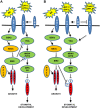What causes opposing actions of brassinosteroids on stomatal development?
- PMID: 23482875
- PMCID: PMC3641210
- DOI: 10.1104/pp.112.213058
What causes opposing actions of brassinosteroids on stomatal development?
Abstract
The TOO MANY MOUTHS receptor may be responsible for the organ-specific effects of brassinosteroids.
Figures

Similar articles
-
Interactions among gibberellins, brassinosteroids and genes regulate stomatal development in the Arabidopsis hypocotyl.Int J Dev Biol. 2017;61(6-7):383-387. doi: 10.1387/ijdb.170021LS. Int J Dev Biol. 2017. PMID: 28695957
-
One more role for the brassinosteroid regulators: BZR1 and BES1 inhibit stomatal development in Arabidopsis cotyledons.Plant Physiol. 2024 May 31;195(2):1106-1107. doi: 10.1093/plphys/kiae092. Plant Physiol. 2024. PMID: 38378164 Free PMC article. No abstract available.
-
Relationship between brassinosteroids and genes controlling stomatal production in the Arabidopsis hypocotyl.Int J Dev Biol. 2012;56(9):675-80. doi: 10.1387/ijdb.120029ls. Int J Dev Biol. 2012. PMID: 23124966
-
The role of brassinosteroids and abscisic acid in stomatal development.Plant Sci. 2014 Aug;225:95-101. doi: 10.1016/j.plantsci.2014.05.017. Epub 2014 Jun 2. Plant Sci. 2014. PMID: 25017164 Review.
-
Molecular control of stomatal development.Biochem J. 2018 Jan 31;475(2):441-454. doi: 10.1042/BCJ20170413. Biochem J. 2018. PMID: 29386377 Free PMC article. Review.
Cited by
-
Brassinosteroid regulates cell elongation by modulating gibberellin metabolism in rice.Plant Cell. 2014 Nov;26(11):4376-93. doi: 10.1105/tpc.114.132092. Epub 2014 Nov 4. Plant Cell. 2014. PMID: 25371548 Free PMC article.
-
Stomatal development in Arabidopsis.Arabidopsis Book. 2013 Jun 6;11:e0162. doi: 10.1199/tab.0162. Print 2013. Arabidopsis Book. 2013. PMID: 23864836 Free PMC article.
-
Mitogen-Activated Protein Kinase Cascades in Plant Hormone Signaling.Front Plant Sci. 2018 Oct 8;9:1387. doi: 10.3389/fpls.2018.01387. eCollection 2018. Front Plant Sci. 2018. PMID: 30349547 Free PMC article. Review.
-
Antagonistic regulation of the meristemoid-to-guard mother-cell-transition.Front Plant Sci. 2013 Oct 11;4:401. doi: 10.3389/fpls.2013.00401. eCollection 2013. Front Plant Sci. 2013. PMID: 24130569 Free PMC article. No abstract available.
-
Hormonal impact on photosynthesis and photoprotection in plants.Plant Physiol. 2021 Apr 23;185(4):1500-1522. doi: 10.1093/plphys/kiaa119. Plant Physiol. 2021. PMID: 33793915 Free PMC article. Review.
References
-
- Abrash EB, Bergmann DC. (2010) Regional specification of stomatal production by the putative ligand CHALLAH. Development 137: 447–455 - PubMed
-
- Berger F, Linstead P, Dolan L, Haseloff J. (1998) Stomata patterning on the hypocotyl of Arabidopsis thaliana is controlled by genes involved in the control of root epidermis patterning. Dev Biol 194: 226–234 - PubMed
-
- Bhave NS, Veley KM, Nadeau JA, Lucas JR, Bhave SL, Sack FD. (2009) TOO MANY MOUTHS promotes cell fate progression in stomatal development of Arabidopsis stems. Planta 229: 357–367 - PubMed
-
- Bergmann DC, Lukowitz W, Somerville CR. (2004) Stomatal development and pattern controlled by a MAPKK kinase. Science 304: 1494–1497 - PubMed
Publication types
MeSH terms
Substances
LinkOut - more resources
Full Text Sources
Other Literature Sources

